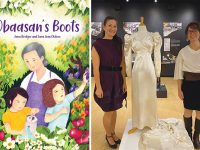Multi-disciplinary artist Kaylie Kreatrix or Kaylie Hatashita performs Kimiko, a poetic circus show at the Ottawa Fringe undercurrents festival. Photo credit: Pixzabelle.
OTTAWA — All eyes in the audience at the Arts Court Theatre are trained on the kimono-clad performer, Kaylie Kreatrix, at the centre of the stage, riveted by the spotlight glinting off the Japanese sword, a katana (かたな), held carefully but confidently in her hands as she prepares to swallow the blade.
Sword-swallowing is the grand finale of Kimiko, a 70-minute “poetic circus show” created by multi-disciplinary artist Kaylie Kreatrix, which she performed at the Ottawa Fringe undercurrents festival in February 2024.
Kaylie Kreatrix is the stage name for Kaylie Hatashita, a Yonsei born and raised in Ottawa, who is using her passion for performing arts to connect with her family’s Japanese heritage and culture. Hatashita has been performing her entire life, even travelling to Australia, where she started studying and practicing circus arts like juggling, aerial acrobatics, and balancing objects on her face and body.

Multi-disciplinary artist Kaylie Hatashita has been exploring Edo Daikagura as a way to connect her practice to her culture. Photo credit: Catherine Tetreault.
“I got obsessed with balancing things,” said Hatashita in an interview, “to the point of giving myself neck injuries from looking up for too long!”
Learning new skills and honing her craft are integral to being a professional performer, which also means researching new tricks. Two years ago, Hatashita stumbled across a curious connection between the circus skills she had been practicing and her Japanese heritage: the practice of Edo Daikagura.
Edo Daikagura is an ancient form of performance art in Japan, dating back 400 years to the Heian period, and includes juggling arts, balancing, and spinning objects. By changing up some of her props, Hatashita realized she was organically connecting to her Japanese heritage.
“Circus has become something more than circus to me,” she said. “In some way, doing Edo Daikagura has given me a way to have insight, to be good at something Japanese.”
Hatashita leaned into her family heritage and Daikagura when she developed the initial 20-minute production of Kimiko for the 2023 Ottawa Fringe Festival with the support of the Ottawa Japanese Cultural Centre.
Woven together through music and movement, Hatashita shares family history and experiences with reverence and respect, using audio clips, photos, and spoken word memory to carry the audience along on her journey of discovering her cultural roots.

Some of the props Hatashita uses in her show, Kimiko. Photo credit: Andrea Sakiyama Kennedy.
Expanding the production to 70 minutes allowed Hatashita to undertake a deeper exploration of her relationship to her art and her family’s connection to their culture. It also offered more space and time for the predominantly non-JC audience to consider the traumatic ripple effects of displacement and disconnection through generations of Japanese Canadians.
During the breathtakingly beautiful fan dance, Hatashita shared with the audience that her father had a childhood memory of watching his mother dance with the fan, creating another deeply personal link between Hatashita’s art and her family history.
Black and white archival images of family members and belongings were projected onto the rippling fabric of the fan as Hatashita danced. The movement of the images created a sense that they had come to life, inviting audience members to witness the moments the photos were taken.

Multi-disciplinary artist Kaylie Hatashita has been exploring Edo Daikagura as a way to connect her practice to her culture. Photo credit: Catherine Tetreault.
When asked if she felt any reticence about sharing what some might consider her family’s private stories and memories, Hatashita admitted to giving it a lot of thought.
“I kind of like to think in some way, it is [my] story, you know? It’s not all of our [personal] stories, but what they lived passed on to us, and so, it’s a fine balance,” she said.
The vulnerability and honesty of Hatashita’s spoken word, coupled with the beauty and wonder of her skills as a performer, created an intimate and safe space for the audience themselves to become personally engaged in Hatashita’s process of healing from intergenerational trauma, becoming participants, and not merely spectators.
Hatashita shared that one of her goals for creating and performing Kimiko was to encourage others, including family members, to explore their own relationship to culture and family history. She has been inspired by her father’s experience growing up in Waterloo, separated from his culture, and his journey towards embracing his heritage.
“I think he also finds a bit of healing seeing my show and realizing that his kids are actually okay, and we’re excited to be Japanese.”
***
To learn more about Kaylie Hatashita, visit www.kayliekreatrix.com.







 15 Mar 2024
15 Mar 2024
 Posted by Andrea Sakiyama Kennedy
Posted by Andrea Sakiyama Kennedy 














